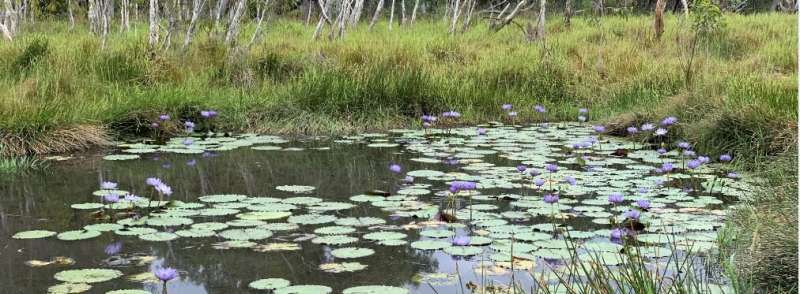Fresh concerns for wetland springs

New research led by Flinders University is renewing calls to protect the source of water and aquifers supporting the ecologically significant Doongmabulla Springs Complex in central Queensland from a proposed Carmichael coal mine in the Galilee Basin.
As work on the Bravus (previously Adani) mine progresses, leading groundwater scientists warn more research is needed to measure and fully understand the aquifer sources that potentially feed the spiritually and environmentally significant springs located near the large inland mine site about 300km from the east coast of Australia.
"Even if the springs' source aquifer is partially dewatered for mining operations, there is a serious threat of permanent damage," says Flinders University Ph.D. candidate Mr Robin Keegan-Treloar, the lead author of a new paper in the international Journal of Hydrology.
"Our study expands on existing water level data, undertaking the most rigorous analysis so far, and even now we cannot definitively identify the source of water to the springs.
Mr Keegan-Treloar says that without better knowledge of the hydrogeology of the area, the springs are at risk of "irreversible decline."
"These concerns have been raised in this study, as well as CSIRO and Geoscience Australia studies, about threats to the springs from the Carmichael mine," he says.
Despite previous warnings, and remaining uncertainties over the effects of nearby mining operations, the mine is still going ahead, says senior author, Flinders University Professor Adrian Werner, from the National Centre for Groundwater Research and Training.
"These findings have important implications given that the Permian Formations will be dewatered by the operation of the nearby Carmichael coal mine," Professor Werner says.
"Lowering the uncertainty of permanent damage to the springs will require new drilling and seismic studies to adequately identify the hydrogeological regime between the mine site and the springs."
The research group says the techniques used in the latest study help to identify and quantify conceptual model uncertainties, although further work is needed.
Research is ongoing, with follow-up studies being conducted using water chemistry, geophysics and numerical modeling.
"The latest study have important implications given that the Permian Formations will be dewatered by the operation of the nearby mine," Mr Keegan-Treloar says. "Lowering the uncertainty of permanent damage to the springs will require new drilling and seismic studies to adequately identify the hydrogeological regime between the mine site and the springs."
More information: Robin Keegan-Treloar et al, Application of Indicator Kriging to hydraulic head data to test alternative conceptual models for spring source aquifers, Journal of Hydrology (2021). DOI: 10.1016/j.jhydrol.2021.126808
Provided by Flinders University




















